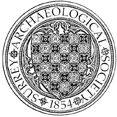Town Hall, Staines
A watching brief on groundworks at the Town Hall and some excavation was carried out by P M G Jones of SCAU for Spelthorne Borough Council. This confirmed that the building lay over medieval and Roman near-shore muds and silts which were sealed below 16th-17th century levels, probably representing foreshore reclamation. A reed peat filled feature of 15th century date was recorded, which contained numerous cut offs of wood and scraps of leather. The earliest buildings on the site appear to be late 15th or 16th century in date.


